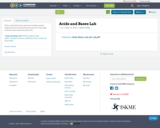
This is a lab followed by questions to help students understand how acids and bases interact. It also helps students understand how pH works.
- Subject:
- Chemistry
- Physical Science
- Material Type:
- Activity/Lab
- Date Added:
- 05/14/2019

This is a lab followed by questions to help students understand how acids and bases interact. It also helps students understand how pH works.
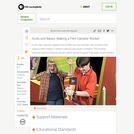
In this video segment adapted from ZOOM, two cast members demonstrate what happens when vinegar is added to baking soda inside a container. The resulting chemical reaction produces enough carbon dioxide to launch their paper rocket skyward.
Recommended for: Grades K-5
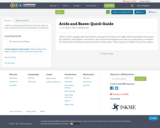
A link to a google presentation that covers the topics of acids, bases, pH, indicators, neutralization, and titration
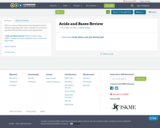
This is a review of information that should have been learned regarding acids, bases, and pH. It is a series of questions followed by answers and explanations.
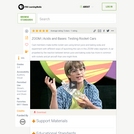
A car propelled by the reaction between lemon juice and baking soda has more in common with rockets and jet aircraft than one might think. In this video segment adapted from ZOOM, two cast members demonstrate the power of rocket-propelled vehicles and how to exploit the force produced by the carbon dioxide gas. Grades 3-8.
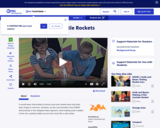
It would seem that bottles of lemon juice and rockets have only their basic shape in common. However, as two cast members from ZOOM demonstrate in this adapted video segment, when baking soda is added to the mix, a plastic bottle can act very much like a real rocket. Grades 3-8.

In this section we will be talking about the basics of acids and bases and how acid-base chemistry is related to chemical equilibrium. We will cover acid and base definitions, pH, acid-base equilibria, acid-base properties of salts, and the pH of salt solutions.
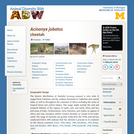
Acinonyx jubatus: Information
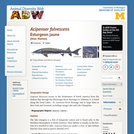
Acipenser fulvescens: Information
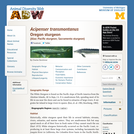
Acipenser transmontanus: Information

Verbal or non-verbal acknowledgement should be used frequently to recognise students demonstrating expected behaviours. Praise emphasises the effort students have made to exceed behaviour expectations specific to them.
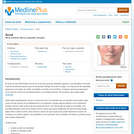
This patient education program explains acne including the causes and treatments. This resource is a MedlinePlus Interactive Health Tutorial from the National Library of Medicine, designed and developed by the Patient Education Institute.
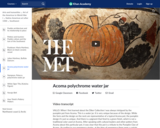
Acoma polychrome water jar, c. 1890, from Acoma, clay and pigment, 25.1 x 29.8 cm (The Metropolitan Museum of Art); speaker: Brian Vallo, Director, Indian Arts Research Center School for Advanced Research, Santa Fe, New Mexico. Created by The Metropolitan Museum of Art.
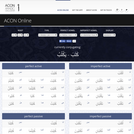
This site's sole function is to provide users with full conjugations of Arabic verbs. It allows users to select any three letter root from a pick a verb form (I-X) and then view a list of the verb conjugated for all pronouns in present and past tense, passive and active voice, and in all three Arabic verb cases.
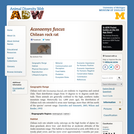
Aconaemys fuscus: Information

Students play and record the “Mary Had a Little Lamb” song using musical instruments and analyze the intensity of the sound using free audio editing and recording software. Then they use hollow Styrofoam half-spheres as acoustic mirrors (devices that reflect and focus sound), determine the radius of curvature of the mirror and calculate its focal length. Students place a microphone at the acoustic mirror focal point, re-record their songs, and compare the sound intensity on plot spectrums generated from their recordings both with and without the acoustic mirrors. A worksheet and KWL chart are provided.
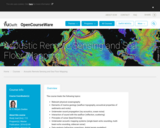
The course treats the following topics: - Relevant physical oceanography - Elements of marine geology (seafloor topography, acoustical properties of sediments and rocks) - Underwater sound propagation (ray acoustics, ocean noise) - Interaction of sound with the seafloor (reflection, scattering) - Principles of sonar (beamforming) - Underwater acoustic mapping systems (single beam echo sounding, multi-beam echo sounding, sidescan sonar) - Data analysis (refraction corrections, digital terrain modelling) - Applications (hydrographic survey planning and navigation, coastal engineering) - Current and future developments.

This course will begin with brief overview of what important current research topics are in oceanography (physical, geological, and biological) and how acoustics can be used as a tool to address them. Three typical examples are climate, bottom geology, and marine mammal behavior. Will then address the acoustic inverse problem, reviewing inverse methods (linear and nonlinear) and the combination of acoustical methods with other measurements as an integrated system. Last part of course will concentrate on specific case studies, taken from current research journals. This course is taught on campus at MIT and with simultaneous video at Woods Hole Oceanographic Institution.
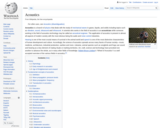
This title gives you a brief introduction on Acoustics for Undergraduate Level students. Its a part of an Assignment for OER Empowering Teachers.

Acoustics (from Greek ακουστικός pronounced akoustikos meaning "of or for hearing, ready to hear") is the science that studies sound, in particular its production, transmission, and effects. The science of acoustics has many applications which are dependent upon the nature of the sound that is to be produced, transmitted or controlled.